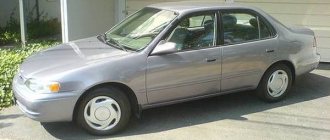Actually, I would like to talk about the car itself and a little about choosing this particular model. I was looking for a Fielder, specifically a hybrid, intact, in good configuration and with mileage in the region of 50. I used to drive both 20th and 30th Priuses - I know their big advantages and annoying disadvantages well. Fielder isn't perfect either. If, for example, the Prius is created as an independent hybrid model, which should push the boundaries of the usual, then the Fielder is simply an adaptation of an independently successful gasoline model to the needs of the public who want greater efficiency. That is, since 2012, the 160th Fielder body has been released, and in August 2013, an almost completely identical hybrid power plant from Toyota Aqua is installed in it, and we have the NKE-165 body. Which, in general, I think was not difficult, because... The 160th Fielder shares the same platform with both Aqua and Witz. Suspension parts and more fit together. Because of this, the new Fielder looks smaller from the outside than its predecessors, and also weighs less. It’s good that, thanks to competent ergonomics, the interior space was not damaged, and even grew by some crumbs compared to the 140m body. But I think what will be more interesting to many is not the comparison of the Fielder with the previous body or another model, but the difference between a hybrid and a non-hybrid one. The hybrid is noticeably heavier due to the high-voltage battery (HVB), which is located under the rear seat (by the way, there is a 12-volt battery there) and due to the inverter-converter under the hood. Although the second is in question (the battery was not easy to migrate back). By the way, the high-voltage wire from under the hood goes to the VVB directly under the bottom in an orange corrugation along the left threshold. It does not look protected from the influence of the Russian road topography due to some unfortunate combination of circumstances... Hybridity did not affect the volume of the interior and trunk in any way. On the outside, the hybrid is distinguished, in addition to the nameplates on the wings and trunk, by a different radiator grille and Toyota emblems on a blue background - like all hybrids of this brand. Hybrid Fielders exist only in front-wheel drive, and in winter the only help you have is good tires and good anti-skid (VSC + TRC), which by the way can be switched off. It works very correctly, as on the 30th Prius, allowing it to slip, but without spinning the drive wheels to the point of squealing - it simply allows them to spin, say, 10-20 km/h faster than the rear ones. By default, Hybrids also have slightly richer internal equipment, for example, they all have push-button climate control with an air ionizer and a multifunction steering wheel (full or half) and a chic on-board computer display next to the speedometer. I will definitely talk about its functionality separately and with photos another time. The hybrid is not very fast in pedal-to-the-floor acceleration and the dynamics theoretically depend on the battery charge level, because The internal combustion engine has only 74 hp. But practically the difference can only be felt if you press the gas pedal for a long time on a battery that has previously been discharged somewhere in a traffic jam, then the charge will run out and only the internal combustion engine will have thrust. If you don't play racing, you may never encounter this in the entire time. The charge is replenished quickly, both due to the internal combustion engine and due to braking (recuperation). The hybrid drives with a characteristic trolleybus sound “piiii-uuu”, and it can be heard better inside in silence than outside. The hybrid hardly wears out brake pads and discs since deceleration in most cases is due to motor generators and the pads are connected only at speeds below 7-10 km/h. By the way, this transition is not noticeable, compared to the first Priuses, when there was like a split-second gap between the recovery and the pads. Yes, I remember, this transition is felt on the Fielder, if the car has been standing in the rain for a day and the brake discs are covered with a coating of rust - then the first braking is accompanied by a noticeable dive with a slowdown when switching to the pads. And at other moments everything is smooth. On Priuses, front pads are rarely changed at mileages of up to 200 thousand km. Now the Feeder has 67 miles on it and there are no signs of wear on the discs or pads. The Hybrid Fielder has small volumes of refueling both gasoline and technical fluids - only 4 liters were spent in both cooling circuits (yes, there are two: for the internal combustion engine and the inverter), oil in the internal combustion engine 3.7 (as in a regular one), oil in the transmission - 3L (Toyota WS), tank is only 35 liters, but never fit more than 29L. While it was warm, I went to the gas station after about 700 km. The Hybrid has an electric air conditioner - you don’t need to start the engine to cool the interior. If only he had a stove from the VVB, otherwise now, with the arrival of cold weather, the internal combustion engine almost never stalls on short trips, because... The interior heating is turned on and the consumption becomes closer to summer non-hybrid. The presence of standard heated front seats is a big plus, but I’m not sure that its non-hybrid counterparts don’t have it. Most likely, the heating option is available for an additional fee to everyone. But that’s exactly what my equipment is called according to the catalogue: “Hybrid G Seat Heater”.
Well, perhaps these are all the differences that are immediately remembered. The rest of the differences are the difference in the configurations, such as lens xenon with auto-corrector, different finishing of the instrument panel and doors, smart key and keyless entry for three doors, normal sound in the doors, a camera with trajectories, heated mirrors, different upholstery seats and other little things.
Toyota Alphard Hybrid
Toyota Alphard models are Hybr />
Appearance of Toyota Alphard 3
The Toyota Alphard model is divided into two types: classic hybrid (released in mid-2015) and restyled (early 2018). Auto 3 modifications are characterized by precise sporty body lines, a wide windshield and an updated style of side windows. At the front there is an enlarged radiator grille and two-section headlights.
Interesting to know! The dimensions are simply impressive: length – 4.945 m, height – 1.945 m, width – 1.8 m. 7 passengers can easily fit into the cabin.
Interior
The seven-seater car is equipped with comfortable leather seats equipped with additional functions - ventilation and electrical adjustment.
The torpedo is finished in wood. An electronic monitor and various sensors are located here. The on-board computer is a smart system with a 4.2-inch touch screen.
Specifications
The Toyota Alphard Hybrid model is a functional minivan with decent technical characteristics:
- main engine 2.5 l;
- 4 valves, 4 cylinders;
- power 152 hp;
- all-wheel drive;
- 2 electric motors - front (143 hp) and additional (68 hp);
- average fuel consumption 5.4 liters per 100 km
Options and cost
The 2021 restyled version is available in the “Lux”, “Prestige” and “Executive Lounge” configurations. All modifications are equipped with precipitation sensors, digital rear-view mirrors, climate and cruise control systems, advanced parking sensors and many other modern technologies. The price of a hybrid car varies from 120 thousand dollars.
Exterior of Toyota Fielder hybrid
The appearance of the Toyota Fielder Hybrid is ambiguous. Much of the exterior is carried over from the Corolla Axio sedan. At the front there is a large air intake covered with a grille. Complexly shaped headlights extend onto the line of the body. At the bottom of the wheel arches, in the recess, the foglights are located.
Fielder's profile doesn't particularly stand out. The wheel arches have the usual lip, and the familiar Hybrid lettering is placed near the front door on the left side.
Front view of Toyota Fielder hybrid
At the rear we are greeted by a neat tailgate. The headlights from the body neatly fit onto it. A spoiler with “fake optics” is installed on top. These are just reflectors without LEDs inside.
Toyota Fielder hybrid side view
Toyota Corolla Fielder Hybrid
The Toyota Corolla Fielder model with a Hybrid engine combines reliability, quality and modern automotive trends.
Appearance
The station wagon is available in 9 colors, and “metallic blue” is typical for this model. The appearance of the Toyota Fielder Hybrid model is characterized by a smooth shape, elongated headlights and a large air intake. The manufacturer's logo has been slightly modified.
Interesting to know! The extended trunk and impressive dimensions (length – 4,360 m, width – 1,695 m, height – 1,475 m) are recognizable features of the car.
Interior
The budget line is characterized by a dark interior design. Expensive options boast a blue panel color. There is a huge color LCD display on the on-board console. The instrument panel is indicated by an analogue speedometer and tachometer scale.
Three-spoke leather steering wheel. The interior is spacious and can accommodate 5 passengers. The seats are comfortable and height adjustable.
Specifications
Toyota modification Fielder Hybrid is equipped with:
- 1.5 liter fuel engine with power ratings of 74 hp;
- 61 hp electric motor
The total power plant is 135 horses. A Japanese minivan consumes 3 liters per 100 km in the city, and even less on the highway. The front-wheel drive station wagon is available with automatic transmission, CVT and manual transmission.
The suspension of the Toyota Fielder modification with a hybrid engine is standard: there is a MacPherson strut in the front, a torsion beam in the rear, and the braking system has some drawbacks. Its design is a little outdated, because... There are standard brake discs at the front and drums at the rear wheels. Minivans have two types of transmission – 2VD and 4VD.
Options and cost
Toyota Corolla modification Fielder Hybrid is available on the market in three configurations.
X – basic model
Equipped with climate control systems, headlight color switch. Other features include automatic braking when there is a risk of a frontal collision, downhill helper, corrections based on road markings, BAS stabilization and the ABS anti-lock system.
Toyota Fielder hybrid: characteristics, review, review
Author avtobond Reading time: 10 min. 1k.
Updated 10/16/2020 In 2000, the Japanese company Toyota introduced an interesting station wagon, the Corolla Fielder. It bears little resemblance to the classic Corolla model. A modified body, a new design, and other technical characteristics - all this created a completely new car, which retained only a piece of the legendary Corolla. Toyota also released this model in a hybrid version. We will tell you about the Toyota Fielder hybrid below.
You might be interested
Here you can learn more about another hybrid - this is the Toyota Auris
Toyota Auris Hybrid
The third generation Toyota hatchback Auris Hybrid was presented in 2018 in Geneva.
Appearance
Toyota Auris Hybrid modification has undergone some changes. The radiator grille has become wider and the air intakes are larger, giving the car style and audacity. The updated optics with LEDs immediately catches the eye. The headlights and taillights changed their shape and stretched out a little - a kind of emphasis on the strength and power of the model. The 2021 version of the hatchback has a chic sports body in several colors.
Interior
The interior and individual elements are trimmed in dark leather. The instrument panel is equipped with a large multifunctional display. The seats are low-slung, the dashboard is located vertically. The windshield is slightly obstructed, which makes it more aerodynamic. For the convenience of travel, everything in the cabin is thought out: there are cup holders and armrests.
Specifications
The third generation Toyota Auris Hybrid modification has increased its technical characteristics. The Japanese car received a powerful power plant, represented by a 1.8-liter gasoline engine and an electric motor with up to 122 hp. The battery is charged automatically during braking. The car accelerates to 180 km/h in 10.9 seconds. Fuel consumption in an urban environment is 3.9 liters per 100 km. The transmission in the Toyota Auris Hybrid generation is automatic variator, front-wheel drive.
Options and cost
The hatchback's equipment is extensive. The manufacturer equipped the car with the following systems:
- climate control and sound insulation;
- assistance when climbing a hill - HLA, HAS, HAC, Hill Holder;
- parking, heated windows and mirrors;
- safety – traction control, braking force distribution, directional stability and child locks;
- multimedia – 6 speakers, steering wheel remote control, radio, Bluetooth, touch screen, MP3, CD.;
- headlight adjustments;
- anti-theft – central locking and immobilizer;
- airbags.
Buy a Japanese economical car Toyota Auris Hybrid at the official price from 32 thousand dollars.
Operation in winter
There are no problems with winter trips in the Fielder hybrid. In the cold season, the heat flow from the hybrid installation is directed directly into the cabin, and in the summer it is discharged outside. The cabin becomes warm after just a couple of minutes.
The battery loses almost no power at low temperatures. If you are not going to use the car for more than 3 days, then place it in a heated parking lot or in an insulated garage.
Important! When the hybrid is idle in the cold season, the battery begins to gradually lose power and resource intensity. There is a high probability that after two weeks the battery will be in critical condition and will need to be replaced.
The developers also provided heated seats and steering wheel, heated rear view mirrors and rear window. The wipers are equipped with a special precipitation sensor, so they turn on automatically when necessary.
Toyota Highlander Hybrid
Toyota's heavy-duty car, the Highlander Hybrid, has gained popularity among many consumers.
Features of the Hybrid version
The Japanese brand Toyota Highlander emerged in 2007, and the hybrid was released in 2008. The 2021 version has increased power and dynamics, and the 2021 model is an SUV with the Lexus RX-Toyota Harrier platform and a powerful power unit.
Innovations
The Toyota Highlander model features a standard hybrid engine and dramatic changes in appearance. The trapezoidal radiator grille is divided into two halves and covered with chrome. The fog lights have become vertically elongated. The rear and front optics have undergone a transformation: the lighting lenses have become the same size.
The rear lights were smoothed out and made the main ones. Lighting technology has changed to 3D visualization with LED equipment. There are running boards on the sides to complement the exterior. The 19-inch wheels are made of titanium alloy.
Interior
Specifications
The hybrid version of the Highlander is equipped with:
- 6-cylinder engine with a power of 290 hp;
- Automatic transmission with 8 steps;
- load distribution system on the front and rear axle elements with a clearance of 20.4 cm.
The maximum speed of an all-wheel drive SUV is up to 180 km/h. In city conditions, fuel consumption is 12.8 liters per 100 km.
Options and cost
Toyota Highlander model with a hybrid engine is known for its Safety Sense technology - protecting the driver, passengers and pedestrians. The transport equipment is presented:
- anti-lock ABS;
- dynamics stabilizer;
- assistant when moving downhill;
- wheel pressure controller;
- navigation and multimedia;
- emergency braking;
- climate control;
- recognition of road signs and markings.
The cost of a modern hybrid SUV starts at $33,000.
dimensions
The body parameters of the third generation Toyota Corolla Fielder station wagon have significant differences from previous versions. Its dimensions were slightly reduced: length by 6 cm and height by 0.5 cm, but at the same time, passengers in the rear row seats received 4 cm more legroom, and the trunk became 9 cm longer.
The overall dimensions of the hybrid version of the Fielder station wagon of the 2013 model year are slightly different from the gasoline versions and have the following indicators:
- number of doors/seats - 5;
- length/width/height - 4360/1695/1475 mm;
- wheelbase - 2600 mm;
- front/rear track - 1480/1475 mm;
- minimum ground clearance - 155 mm;
- total curb weight - 1455 kg;
- wheel size - 185/60 R15.
Toyota Avalon Hybrid
Toyota Avalon Hybrid modification is a front-wheel drive E-class sedan.
Appearance
The car has a radiator grille in the form of horizontal slats with a double bend. The fog lights are made in the form of vertical stripes. The front optics are slightly recessed into the streamlined and smoothed body.
Interior
A notable feature of the interior is that on the left side of the dashboard, instead of a tachometer, there are informative divisions. They display all the indicators of mode, power, and battery charge.
The panel contains monitors responsible for multimedia systems and climate control. The seats are trimmed with perforated leather. Driver and front seats are heated and ventilated. The rear passenger seats only have heating.
Specifications
The electric powertrain is equipped with a nickel-metal hydride battery and a 2.5 liter gasoline engine. The total power of the system is 200 horses.
Options and cost
The Avalon is available in Limited, XLE Premium and XLE Plus trim levels. All models are equipped with climate control systems, navigation and modern traffic safety technology. The official price of the sedan is from 33.5 thousand dollars.
What is the difference between a plug-in hybrid and a hybrid?
First, you need to understand what is the difference between a plug-in hybrid and a hybrid. In general, electrically powered vehicles are divided into three groups:
- Battery EV (BEV) - Vehicles use power solely from battery power and have an exclusively electric motor.
- Hybrids (HEV) and plug-in hybrids (PHEV) are cars that use more than one power source to drive the wheels: an electric motor and an internal combustion engine.
- Fuel Cell Electric Vehicles (FCEVs) - Like BEVs, they are driven by an electric motor, but use hydrogen tanks instead of batteries.
The main difference between a hybrid and a plug-in hybrid is that the latter has the ability to be recharged from a charging station and cover short distances using only the battery and electric motor, without connecting the internal combustion engine. While a conventional hybrid charges the battery only during braking or from a running internal combustion engine.
Lineup of other Toyota hybrids
The Japanese brand produces other car models equipped with a hybrid propulsion system:
- Toyota Crown modification Hybrid - 13th generation of an improved sedan with an elegant design with a 3.5 liter gasoline engine and an electric motor with a power rating of 296 hp;
- Toyota Vellfire of the Hybrid generation - an all-wheel drive minivan with a CVT transmission, cool “stuffing” with modern safety, comfort, traffic and parking systems;
- The Toyota Prado Hybrid model, a powerful hybrid SUV, has exceeded all customer expectations. It is characterized by a powerful suspension, elegant body and technological equipment.
The technology of electric power plants and gasoline engines from Toyota ensures the mass production of economical and modern cars equipped with all kinds of safety systems.
«>
Type of hybrid installation Toyota Fielder hybrid
The Toyota Fielder uses a hybrid system - THS II with an electronically controlled transmission. The car uses a series-parallel operating circuit of the installation. It includes an internal combustion engine and one electric motor. The design is complemented by a planetary gearbox and a variable speed transmission. This allows for the most precise transmission of torque.
The presence of a planetary power flow reducer optimizes the amount of energy directed to both the generator and the drive wheels. The electricity generated by the generator is used both to power the electric motor and to recharge the battery.
Toyota Fielder hybrid engine
The total power of the hybrid engine is 100 hp.
Reviews of Toyota Fielder hybrid
Review from Andrey
I purchased Fielder from local companies in the Far East. I haven’t noticed any problems yet, although I’ve only been driving for 6 months. Among the advantages I would like to note are efficiency, design and functionality. The only negative is the ground clearance, so you can’t drive it off-road. But for a country road it is quite enough.
Review from Nikolay
A year after purchasing the hybrid, everything was fine. Over the entire period of use, I noted a couple of shortcomings. The ground clearance didn't suit me, so I had to install spacers. I was pleased with the great functionality, trunk volume and stylish design. Considering that I got the car for a little more than 700,000 rubles, I am happy with the purchase.
Options and prices of Toyota Fielder hybrid
The Toyota Fielder hybrid station wagon is sold in three trim levels - X, G and S. The basic configuration X was discussed above, and all the others are presented with additional functionality. The price of the basic configuration is 1,308,000 rubles.
Package G includes:
- LED optics (in the initial stage - xenon);
- heated rear view mirrors;
- multifunction steering wheel and improved audio system with 4 speakers;
- keyless entry system;
- climate control.
The cost of the G package is 1,380,000 rubles.
The S package does not have many differences. The main features are full leather upholstery and front row sports seats with lateral support, adaptive headrests and adjustment.
The S package will cost 1,490,000 rubles.
Reference! All prices are for new cars. The transfer was made from foreign currency.










